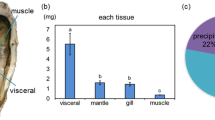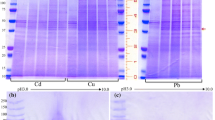Abstract
In contrast to previous results which examined oysters exposed to artificially high cadmium (Cd) levels, the forms of cadmium occurring in “natural” commercially available oysters were partially characterized. About one-third of the Cd was associated with insoluble material. Of the soluble Cd, about 20% occurred in a high molecular weight protein of 40,000–50,000 daltons. The low molecular weight soluble Cd consisted of at least two different forms,i.e., that associated with amino acids (a small peptide) and inorganic Cd. The small peptide fraction also contained zinc and copper. The forms of Cd in commercial oysters were compared to those occurring in both commercial scallops and artificially cultured oysters. Scallops bind Cd to three soluble proteins, all of which are of higher molecular weight than the small oyster peptide. Oysters cultured in 10 ppb Cd medium contained binding sites similar to commercial oysters except that none of the soluble Cd in the cultured oysters was associated with a high molecular weight protein. The results suggest that extremely high environmental Cd levels are necessary to induce a metallothionein-like protein in oysters. Implications of the results to public health are discussed.
Similar content being viewed by others
References
Albert, A.: Quantitative studies of the avidity of naturally occurring substances for trace metals 1. Amino acids having only two ionizing groups. Biochem. J.47, 531 (1950).
Bligh, E. G., and W. J. Dyer: A rapid method of total lipid extraction and purification. Can. J. Biochem. Physiol.37, 911 (1959).
Casterline, J. L., and G. Yip: The distribution and binding of cadmium in oyster, soybean, and rat liver and kidney. Arch. Environm. Contam. Toxicol.3, 319 (1975).
Chou, C. L., J. F. Uthe, and E. G. Zook: Polarographic studies on the nature of cadmium in scallop, oyster, and lobster. J. Fish. Res. Board Can.,3, 409 (1978).
Coombs, T. L.: The nature of zinc and copper complexes in the oysterOstrea edulis. Mar. Biol.28, 1 (1974).
Diamond, P. S., and R. F. Denman: Laboratory techniques in chemistry and biochemistry. New York: Halsted Press (1973).
Eaton, A.: Marine geochemistry of cadmium. Mar. Chem.4, 141 (1976).
Frazier, J. M.: Bioaccumulation of cadmium in marine organisms. Environm. Health Persp.28, 75 (1979).
Hall, R. A., E. G. Zook, and G. M. Meaburn: National Marine Fisheries Service survey of trace elements in the fishery resource. NOAA Technical Report NMFS SSRF-721 (1978).
Hardy, J. T., E. A. Crecelius, S. P. Joyce, and C. W. Apts: Bioaccumulation of cadmium by the oysterCrassostrea virginica in a continuous-feeding algal chemostat system. Unpublished, Battelle Pacific Northwest Laboratories, Sequim, WA (1981).
Jones, J. W., R. J. Gajan, K. W. Boyer, and J. A. Fiorino: Dry ash-voltammetric determination of cadmium, copper, lead, and zinc in foods. J. Assoc. Off. Anal. Chem.60, 826 (1977).
Meaburn, G. M., K. B. Bolton, H. L. Seagran, T. C. Siewicki, S. M. Bingham, and P. J. Eldridge: Application of a computer simulation model to estimate dietary intake of cadmium from seafood by U.S. consumers. NOAA Technical Memorandum NMFS SEFC-74 (1981).
Pfannkoch, E., K. C. Lu, F. E. Regnier, and H. G. Barth: Characterization of some commercial high performance size-exclusion chromatography columns for water-soluble polymers. J. Chromatog. Sci.18, 430 (1980).
Ridlington, J. W., and B. A. Fowler: Isolation and partial characterization of a cadmium-binding protein from the American oyster (Crassostrea virginica). Chem.-Biol. Interactions25, 127 (1979).
Sakurai, H.: Stability constants of metal complexes of taurine and its related compounds. Ganryu Aminosan2, 305 (1979).
Spies, J. R., and D. C. Chambers: Chemical determination of tryptophan. Anal. Chem.20, 30 (1948).
Tanford, C., and M. L. Wagner: Consecutive constants for the association of cadmium with imidazole. J. Am. Chem. Soc.75, 434 (1953).
Author information
Authors and Affiliations
Additional information
Contribution Number 83-10C, Southeast Fisheries Center, National Marine Fisheries Service, NOAA, Charleston, SC 29412-0607
Use of trade names is for informational purposes and is not intended as an endorsement of the product(s) by this agency
Rights and permissions
About this article
Cite this article
Siewicki, T.C., Sydlowski, J.S. & Webb, E.S. The nature of cadmium binding in commercial Eastern Oysters (Crassostrea virginica). Arch. Environ. Contam. Toxicol. 12, 299–304 (1983). https://doi.org/10.1007/BF01059406
Received:
Revised:
Issue Date:
DOI: https://doi.org/10.1007/BF01059406




